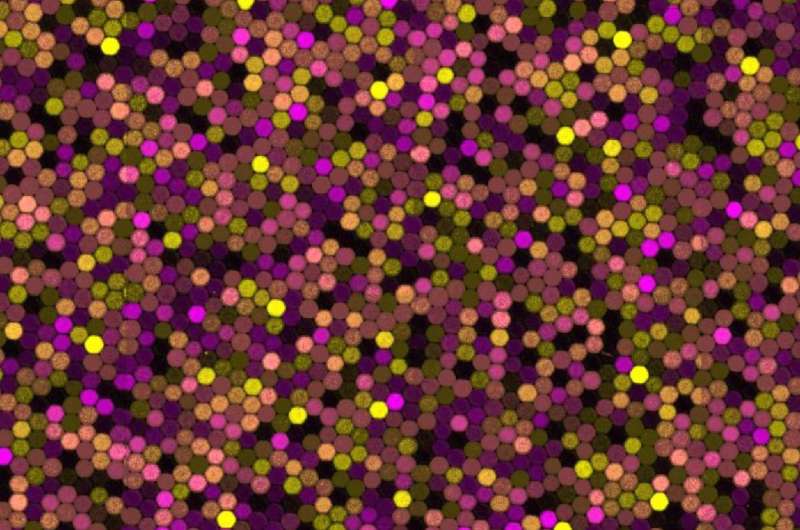10,000 windows onto biomolecular information processing

A Franco-Japanese research group at the University of Tokyo has developed a new "brute force" technique to test thousands of biochemical reactions at once and quickly home in on the range of conditions where they work best. Until now, optimizing such biomolecular systems, which can be applied for example to diagnostics, would have required months or years of trial and error experiments, but with this new technique that could be shortened to days.
"We are interested in programming complex biochemical systems so that they can process information in a way that is analogous to electronic devices. If you could obtain a high-resolution map of all possible combinations of reaction conditions and their corresponding outcomes, the development of such reactions for specific purposes like diagnostic tests would be quicker than it is today," explains Centre National de la Recherche Scientifique (CNRS) researcher Yannick Rondelez at the Institute of Industrial Science (IIS).
"Currently researchers use a combination of computer simulations and painstaking experiments. However, while simulations can test millions of conditions, they are based on assumptions about how molecules behave and may not reflect the full detail of reality. On the other hand, testing all possible conditions, even for a relatively simple design, is a daunting job."
Rondelez and his colleagues at the Laboratory for Integrated Micro-Mechanical Systems (LIMMS), a 20-year collaboration between the IIS and the French CNRS, demonstrated a system that can test ten thousand different biochemical reaction conditions at once. Working with the IIS Applied Microfluidic Laboratory of Professor Teruo Fujii, they developed a platform to generate a myriad of micrometer-sized droplets containing random concentrations of reagents and then sandwich a single layer of them between glass slides. Fluorescent markers combined with the reagents are automatically read by a microscope to determine the precise concentrations in each droplet and also observe how the reaction proceeds.
"It was difficult to fine-tune the device at first," explains Dr Anthony Genot, a CNRS researcher at LIMMS. "We needed to create generate thousands of droplets containing reagents within a precise range of concentrations to produce high resolution maps of the reactions we were studying. We expected that this would be challenging. But one unanticipated difficulty was immobilizing the droplets for the several days it took for some reactions to unfold. It took a lot of testing to create a glass chamber design that was airtight and firmly held the droplets in place." Overall, it took nearly two years to fine-tune the device until the researchers could get their droplet experiment to run smoothly.
Seeing the new system producing results was revelatory. "You start with a screen full of randomly-colored dots, and then suddenly the computer rearranges them into a beautiful high-resolution map, revealing hidden information about the reaction dynamics. Seeing them all slide into place to produce something that had only ever been seen before through simulation was almost magical," enthuses Rondelez.
"The map can tell us not only about the best conditions of biochemical reactions, it can also tell us about how the molecules behave in certain conditions. Using this map we've already found a molecular behavior that had been predicted theoretically, but had not been shown experimentally. With our technique we can explore how molecules talk to each other in test tube conditions. Ultimately, we hope to illuminate the intimate machinery of living molecular systems like ourselves," says Rondelez.
More information: A.J. Genot, A. Baccouche, R. Sieskind, N. Aubert-Kato, N. Bredeche, J.F. Bartolo, V. Taly, T. Fujii, Y. Rondelez, "High-resolution mapping of bifurcations in nonlinear biochemical circuits" Nature Chemistry, DOI: 10.1038/nchem.2544
Journal information: Nature Chemistry
Provided by University of Tokyo


















